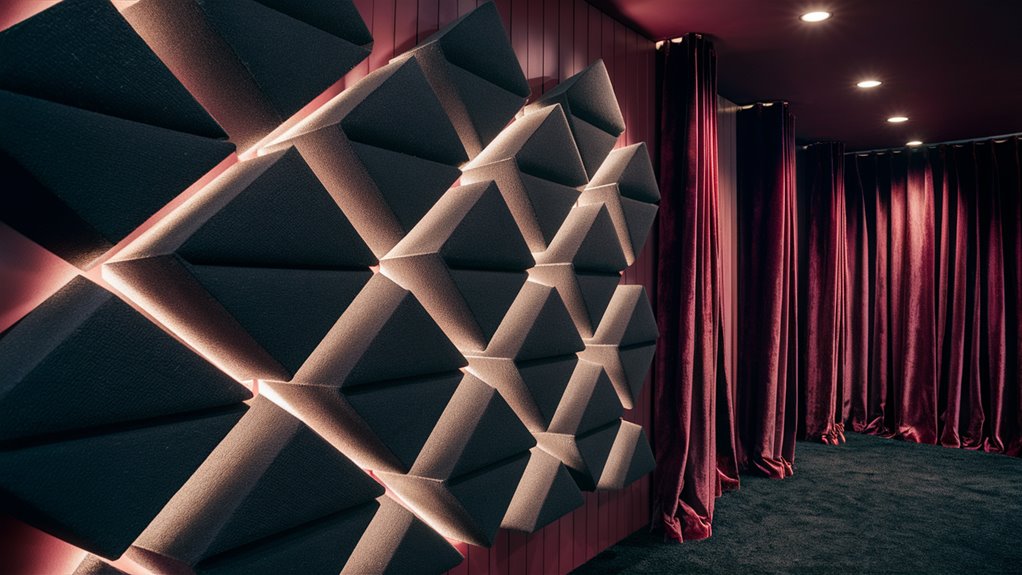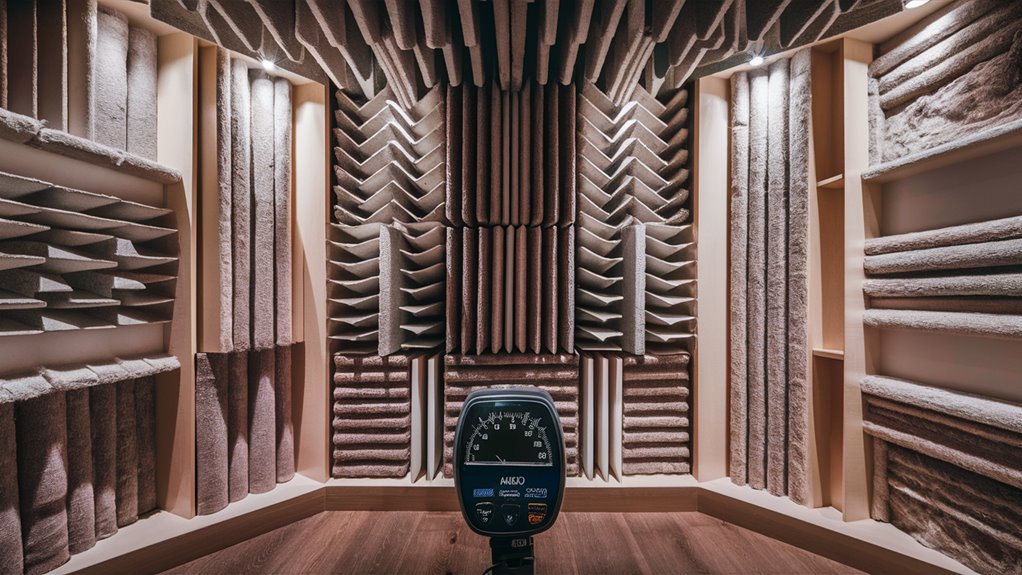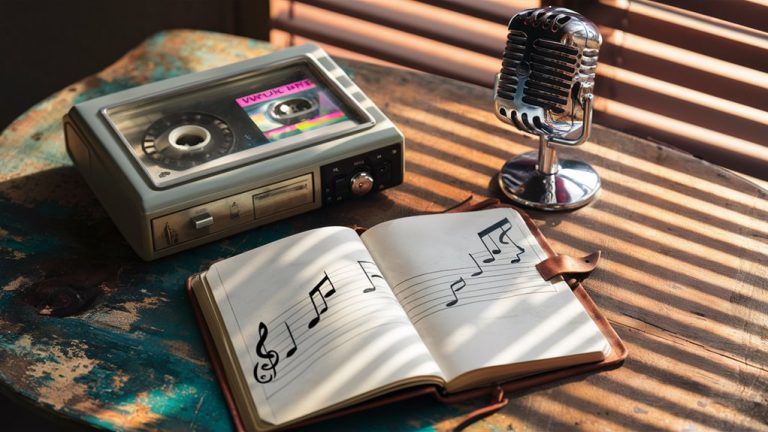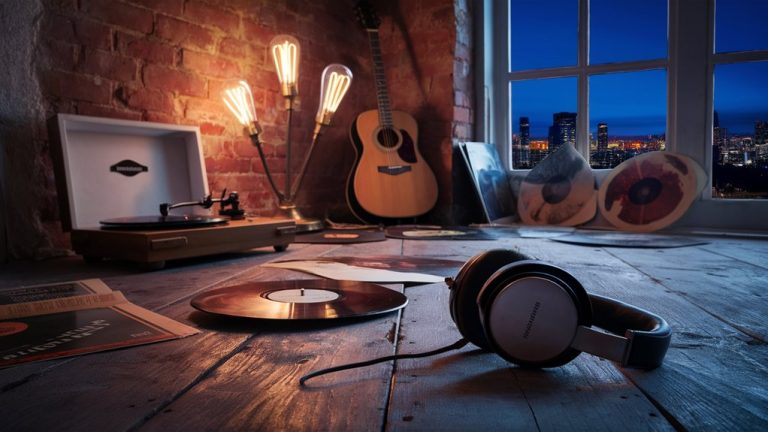
Simple Karaoke Room Soundproofing Guide

Key Materials and Parts
To make a top-level sound-quiet karaoke room, start with these sound-stopping items:
- Heavy vinyl (MLV) that weighs 1-2 lbs/sq ft
- Thick double-layer drywall (5/8″)
- Dense wool for filling (6 lbs/cu ft)
Wall and Ceiling Setup
The wall setup needs many layers to block noise:
- Put up resilient channels every 24 inches
- Seal all gaps and holes with sound sealant
- Hang two layers of drywall with offset edges
- Fill between studs with wool
Door and Entry Ways
Sound-stop doors need:
- Solid doors that are very heavy (at least 4.5 lbs/sq ft)
- Automatic door bottoms to close gaps
- Good seals all around
- Right Karaoke Room
- Several seals for a tight shut
Air and Heating Sound Points
Use sound-focused air setups:
- A double-duct air system
- Noise-reducing parts in ducts
- A lined air return space
- Soft connections that cut sound
Floor Sound Barrier
Build a full sound barrier underfoot:
- Make a floating floor
- Put a MLV layer below
- Use a top-grade floor base (IIC 65+)
- Keep edges away from walls
This full plan keeps sound in, making karaoke better and quieter.
Basics of Sound Moving
How Sound Waves Spread
Sound moves in an area through two main paths: air sound and solid sound. Knowing these sound basics helps manage noise in any place.
Air Sound Moving
Air sound happens when sound travels through the air and hits walls.
Sounds from singing or music can reflect, absorb, or go through walls, ceilings, and floors. Good soundproofing uses this knowledge.
Solid Sound Ways
Solid sound, also called impact noise, moves through the building’s materials.
This sound travels through parts that are stuck together, making noise around. To handle this, you need special isolation ways.
Sound By Frequency
Sounds act differently at each frequency:
- Deep sounds (bass) are tough due to their long waves and power
- High sounds are easier to keep in but can slip through small cracks
- Mid sounds need a good mix of actions
Knowing how sound moves lets you set up good sound systems by:
- Making things heavier to block noise
- Damping to lower shakes
- Breaking connections to stop sound travel
- Soaking up energy to stop noise
Key Soundproofing Materials
Main Sound Stopping Items
Heavy vinyl (MLV) is the base for sound cuts, stopping a lot with its 1-2 lbs per square foot weight.
Sound panels with high noise cut rates (NRC) of 0.85 or more soak up mid and high sounds well.
Bass traps in corners catch deep sounds.
Walls and Ceilings Fix
Resilient channels make needed air gaps between wall parts, cutting sound travel a lot.
Double-layer drywall with damping paste gives great quiet.
Hanging sound tiles with good ratings (55+) are best for ceilings.
Crucial Seals
Rubber seals and stripping seal all around doors.
Wool fill with a minimum 6 lbs per cubic foot ups wall sound soaking, making a full quiet wall.
Installing by Pros
Sound cut clips, quiet caulk, and soft mats finish the pro quiet setup.
Quiet windows with extra panes and special air cuts keep things quiet while letting air move right.
Sound Level Checks, frequency tools, and testing gear check if it’s all installed right and measure sound cuts across different sounds.
Hit test tools and side noise checkers make sure the quiet works well.
Pro Wall and Ceiling Sound Treatment Install Guide
Main Materials and Putting It In
Heavy vinyl starts the sound stopping, right on walls and ceilings.
Resilient channels go across wall studs or ceiling joists, kept at just 24-inch spaces for the best result.
More Layer Moves
Wool placement between studs starts the silence, followed by double 5/8-inch quiet drywall.
Edges that don’t line up stop unwanted sound paths.
Edge sealant and damping paste between drywall layers ups the quiet effect.
A small 1/4-inch gap filled with sound caulk locks in the silence.
Ceiling Special Apps
Sound-rate ceiling boxes and flexible tubes cover weak spots around lights and air moves.
Planned sound panel spots soak up sound well, set with air gaps for top performance.
This full plan makes sure noise is cut across all surfaces.
Advanced Door and Window Quiet Guide

Door Quiet Fixes
Solid doors are a must, with a heavy 4.5 lbs/sq ft or more base.
Good stripping and door sweeps seal gaps well.
Auto door bottoms block sound by sealing tight when shut.
Window Quiet Ways
Two-pane window setups with different thick glass (6mm and 8mm) cuts sound well.
A 4-inch air gap between panes makes good sound gaps. Rubber seals and quiet caulk stop noise leaks around edges.
Window plugs from heavy vinyl and quiet foam are removable for times when you don’t need light.
Laminated glass with noise layers cuts sound by up to 50 decibels, much better than old single-pane windows.
Floor Sound Impact Cuts
Advanced Floating Floors
Floor sound cut needs a complex layer system for the best quiet between floors.
The start is a floating floor setup with heavy vinyl (MLV) as the first quiet layer. Smart placing of rubber pads makes needed air gaps between the base floor and the top layer.
Pro Quiet Materials
To max the quiet, use a thick, dense floor base that’s at least 5mm thick with an Impact Class (IIC) rating of 65 or higher.
This special material works with a second MLV layer below the top floor, making strong quiet.
Targeted Impact Cuts
Impact noise can be cut even more with smart placing of rubber mats in busy spots, cutting sound by up to 30dB.
These mats need careful setting up to stay safe and keep their sound cuts. These quiet ways make a strong block against both air sound and solid shakes.
Air and Sound Cuts for Karaoke Rooms
Top Quiet Air Systems
Sound cuts and right air are big parts of karaoke room design.
Using special air systems with quiet ducts makes a great spot through smart sound cuts and controlled air flow.
Double-Duct Tech and Noise Cuts
Double-duct setups work as good noise traps, and noise cut parts in the ducts keep the air moving with less noise.
Soft tube links stop shakes between air parts and air paths, keeping top sound performance.
Smart Sound Design Bits
Sound-soaking front bits and materials that soak sound help at air ways in and out, while smart silencers aim at specific voice sound ranges.
The design uses smart air changes per hour, thinking about how many people and equipment heat.
This full design gives top sound cuts while keeping needed air rules for karaoke spots.
Main Bits:
- Quiet ducts with many turns
- Sound-soaking covers
- Double-duct style
- Smart noise cut parts
- Soft tube links
- Sound-soaking front bits
- Special voice silencers
Pro Vs DIY Sound Cuts
Pro Sound Cuts: The Good Bits
Pro sound cuts in karaoke rooms come from experts using the best gear, ways, and smart plans for top heavy vinyl use, right channel space, and sound panel places.
DIY Sound Cut Tests
DIY sound projects often meet big problems from wrong setup steps. Big slip-ups include:
- Bad sound barrier seals
- Wrong wall break ways
- Too light sound materials
- Open gaps leaving sound leaks
Choosing Well
Pro setup is key for deep sound cut parts:
- Floating floors
- Double-wall builds
- Top-grade door seals
- 베트남KTV
- Fitting building rules
- Setup promises
- Pro cover plans
DIY Okay for:
Simple sound cuts fit for DIY:
- Easy panel sets
- Door bottom fits
- Simple gap fills
- Basic soak treatments
Pro proof gives the best sound performance and follows the law for big karaoke setups, while DIY fits simple sound fixes within what you can do.






